

The works programming / resource allocation activity defines (PIARC 2012-a) the steps necessary to identify and prioritize the projects that should be carried out in the short and medium term to support the asset management strategy. At the same time, it provides mechanisms to distribute the available budgets among the identified projects in order to realize benefits such as increased safety, mobility and comfort, value for money, and risk mitigation.
Besides explaining the basics and motivation of works programming and the maturity levels associated with it, this chapter presents a detailed description of the works programming process, which includes the following tasks: identify candidate projects and prepare works subprograms by asset class; prioritize the asset class subprograms; prepare and optimize a multi-year works program for a programming period of 3 to 5 years; and prepare and optimize the annual program. The above process should be revised on regular basis to ensure the proposed annual program effectively contributes to achieve the organization strategic objectives.
Works programming refers to the preparation of annual and multi-annual works programs in which road assets requiring treatment are identified, selected, and prioritized and resources are allocated from available funds (Robinson et al. 1998).
Programming implies the application of asset management principles to make decisions at the network or subnetwork level for budget allocation in the short to medium term. Assuming that appropriate levels of service have been set, this process includes identifying asset requirements, developing a total needs program, and prioritizing/optimizing programs for the existent budget constraints (Austroads 2009).
The preparation of works programs has at its core a resource allocation process, which ideally distributes the available funding among projects that have been identified as the best alternatives for investing funds (PIARC 2000). Best practice includes the application of benefit-cost analysis for each candidate project within a lifecycle framework. Modern analysis tools are based on such a framework and provide mathematical optimization routines to determine the best investment choices subject to limited budgets (Cambridge Systematics 2004).
While the economic factor is important, it is not the only criterion used for selecting projects. Other aspects that may also be considered are network connectivity, neighborhood cohesion, preservation of corridor standards, and economic necessity (Cambridge Systematics et al. 2002-1).
At high levels of maturity in asset management, works programming also considers risk and thus applies a risk-based approach when carrying out tasks like identifying candidate projects or prioritizing works programs by road asset (UKRLG and HMEP 2013). In addition, mature works programming features resource allocation across asset classes, which is often implemented using risk criteria as well.
In developing works programs, it is important to make sure that treatment options, intervention criteria, and system priorities comply with established strategic directions (Austroads 2009).
The main goals of the works programming process include the following (Austroads 2002 and UKRLG and HMEP 2013):
Program effectiveness is measured in terms of the program’s contribution to achieving asset management policy and strategic goals, attaining performance targets (PIARC 2012-b) defined by the road organization and meeting the expectations of stakeholders. The efficiency of programs is determined as a function of the benefits generated (user cost savings, improved road safety, congestion reduction, and so on) per investment unit.
Works programs and the associated performance measures and targets, when made publicly available, also provide means for increasing the accountability and transparency of the agency operations.
Ultimately, the goal of works programming in asset management is to deploy, maintain, and operate assets in a manner that maximizes the accomplishment of the organization’s mission (FHWA Transportation Asset Management Expert Task Group 2013).
The level of maturity for works programming can be assessed based on a number of features, such as the length of the programming period, application of analysis tools, or resource distribution across asset classes. In this way, for each maturity level a particular feature may or may not be present, as shown in Table 3.4.3. Maturity levels can then be characterized by the set of features they support.
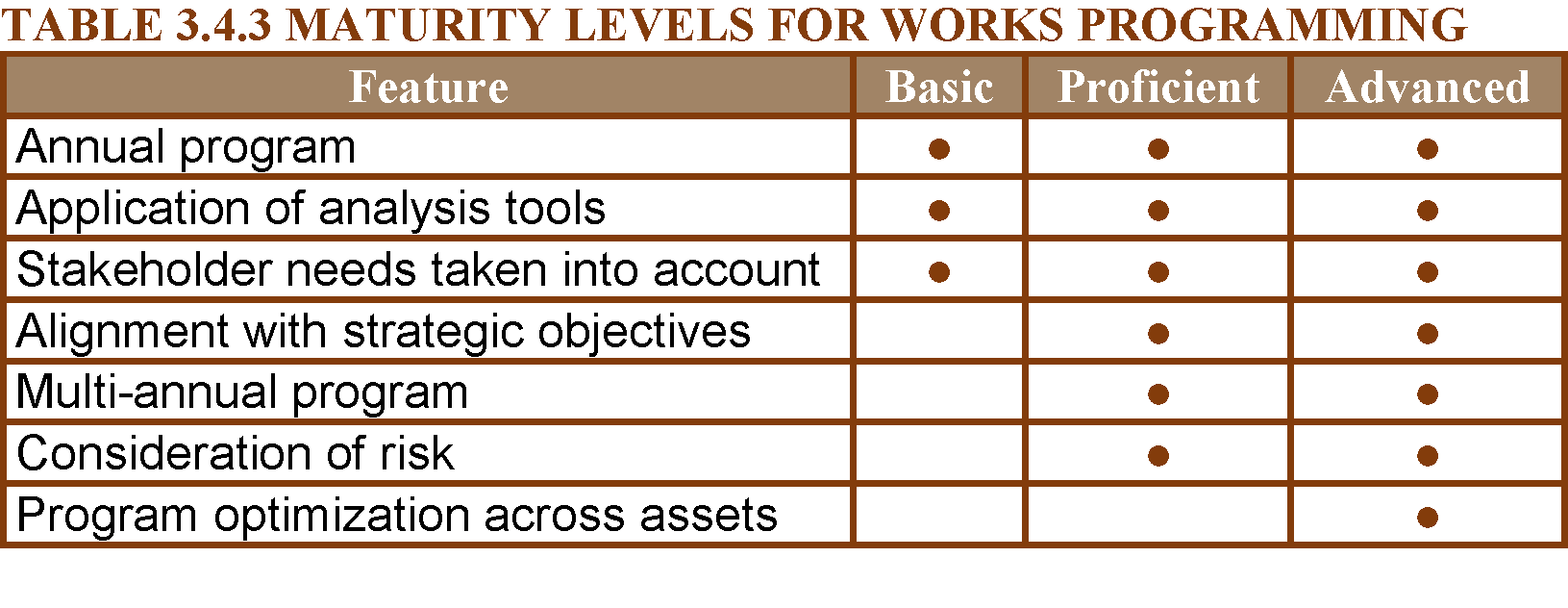
The following sections present a brief discussion of maturity levels with regard to the programming process.
A basic approach to programming normally allows for the production of annual works programs only. At this maturity level, organizational barriers still exist that limit the use of strategic objectives and other elements of planning to support longer programming periods. Another restricting factor for the development of multi-annual programs is a high level of uncertainty with respect to future revenue.
Though analysis tools are present at the basic maturity level, organizations at this stage tend to privilege the implementation of such tools over the improvement of the business process they should support, thus reducing the potential impact that tool use may have on the overall performance of the organization. Nevertheless, at this level return on investment might be used as a basis for decision making when this capability is built into the tools employed.
Also, at the basic level performance models within management systems are frequently not developed or calibrated to an appropriate degree to ensure that local conditions are properly simulated. In this respect, it should be emphasized that all performance models used in asset management systems (road deterioration, traffic assignment, vehicle operating costs, etc.) should be carefully adjusted to local conditions. Using default models, as is done in a number of countries due to economic or technical issues, should be discouraged if not prohibited because all medium- and long-term results from studies such as benefit-cost analysis or risk analysis are strongly dependent on the relevance of the models.
Most management systems in operation at the basic level support works programming only for pavements and, to a lesser extent, for bridges. Budget allocation for assets other than pavements or bridges are often carried out based on historical expenses.
Finally, because management of stakeholders’ expectations is usually also at an early stage, pressure may arise to favor projects addressing the needs of specific groups or projects with special political significance at the expense of other projects with better potential to achieve the goals of the road organization.
A distinctive feature of proficient organizations with respect to works programming is their ability to support development of multi-year work programs. These organizations have typically succeeded in reaching a proficient level in other aspects of asset management, including data management, lifecycle planning, and performance management.
The above is evidenced by the existence of more reliable information and tools. These allow road managers to expand the programming time horizon, which is also leveraged by an increased commitment from senior executives to use business cases effectively in securing funds for road investment over longer periods.
Pavement and bridge management systems are well established as corporate tools, and their application is aligned with the business processes the agency has implemented for allocating resources. Other systems for managing slopes and/or embankments, accidents, and signs may have already been deployed. Evaluation and prioritization of treatment options are based on benefit-cost analysis, particularly in the case of pavements.
At the proficient level, risk is used as an additional criterion to identify and prioritize candidate projects for assets such as bridges, earthworks, and drainage or for projects related to road safety. Risk may also be taken into account to manage sources of uncertainty affecting program delivery, including costs, funding levels, and adverse environmental events. Risk management is an additional factor enabling the agency to prepare multi-year works programs.
This level also features mechanisms for managing stakeholder expectations so that the needs of particular groups are properly balanced with the strategic objectives of the road organization. At the same time, new means for capturing customer perception, such as road user surveys, are put into practice.
Organizations at this stage of maturity have successfully incorporated asset management into their corporate culture and are immersed in a continuous improvement process. In this context, they investigate further actions to enhance the efficacy and efficiency of their business practices.
One of these actions is the implementation of a cross-asset schema for budget allocation, which broadens the scope of project selection and prioritization to ensure that projects that best contribute to the organization’s mission are adequately funded, regardless of the asset class or operational feature each project is related to. A prerequisite for an organization to implement cross-asset resource allocation procedures is the existence of a suitable organizational structure for allowing the steady flow of information that might be required.
Cross-asset methods are still at an early stage of development worldwide. In this regard, risk-based approaches have also proven useful for organizations already engaged in adopting such methods.
Advanced works programming is closely linked to asset management financial planning. On the one hand, financial planning takes as input information regarding historical funding levels and the amount of funds expected to be available in the foreseeable future (FHWA 2013). On the other hand, it defines how these funds will be allocated in the short to medium term.
The overall process of developing works programs and allocating resources to individual projects can be depicted as a sequence of stages, as shown in Figure 3.4.4.

The identification of candidate projects implies the analysis of a given asset (e.g., a pavement section or a bridge) to determine what actions, if any, should be taken to maintain or improve its performance (Cambridge Systematics et al. 2002-2). This analysis relies on information sources like the following: condition surveys, safety inspections, knowledge of local staff, stakeholder needs, accident claims, and requirements to meet corporate objectives. Data from condition surveys and safety inspections should ideally be available from the asset management system, in some cases through advanced platforms such as GIS (UKRLG and HMEP 2013)
A comprehensive approach to project identification may include the following steps (Austroads 2002):
In order to define the projects required to close the gaps identified from the above steps, several treatment alternatives may be evaluated for each asset. Road management systems such as pavement, bridge, accident, and other management systems have been developed over the years to streamline the analysis of alternative works. At this stage, evaluation may include assessing the economic benefits of each option, particularly in the case of pavement assets.
The final lists of candidate projects obtained by identifying the optimal intervention option for the various assets may be referred to as the total needs program (Austroads 2009). Figure 3.4.4.1 contains a simplified representation of the programing stage concerning project identification and the preparation of initial programs.
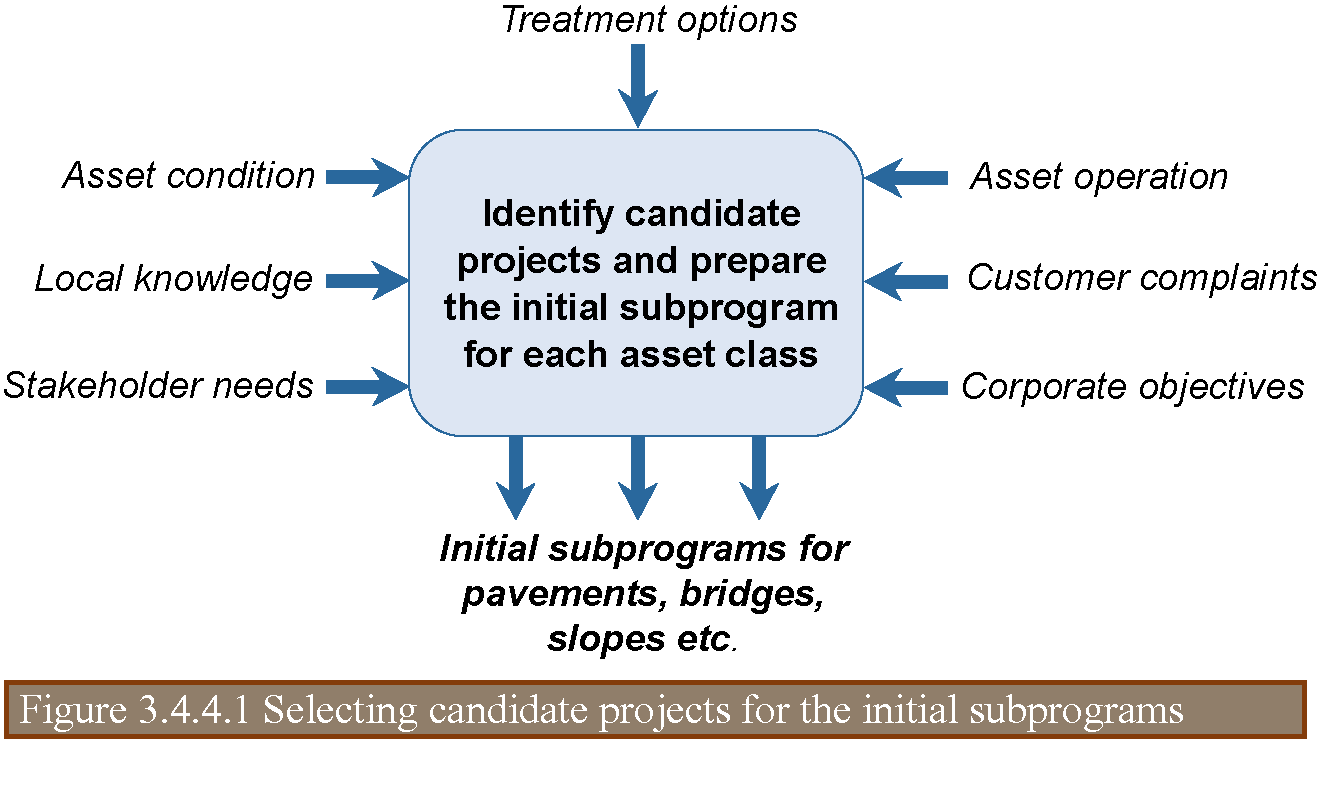
Prioritization is basically a method of arranging proposals on new lists that indicate which projects are to be funded first (Austroads 2009). Each new list corresponds to a prioritized subprogram per asset class. The prioritization process is built upon a set of criteria involving aspects such as physical condition, safety, risk, and economic feasibility.
The initial works program usually includes assets whose performance has fallen below specified standards in terms of condition or safety measures. It may also comprise assets subject to high levels of risk, such as those located in areas of extreme weather conditions as well as those attracting the interest of stakeholders for other reasons (e.g., political or socioeconomic).
Because available budgets will in most cases be insufficient to address all needs, safety-critical assets or those having the highest level of risk (Figure 3.4.4.2.1) will normally be put at the top of the list.
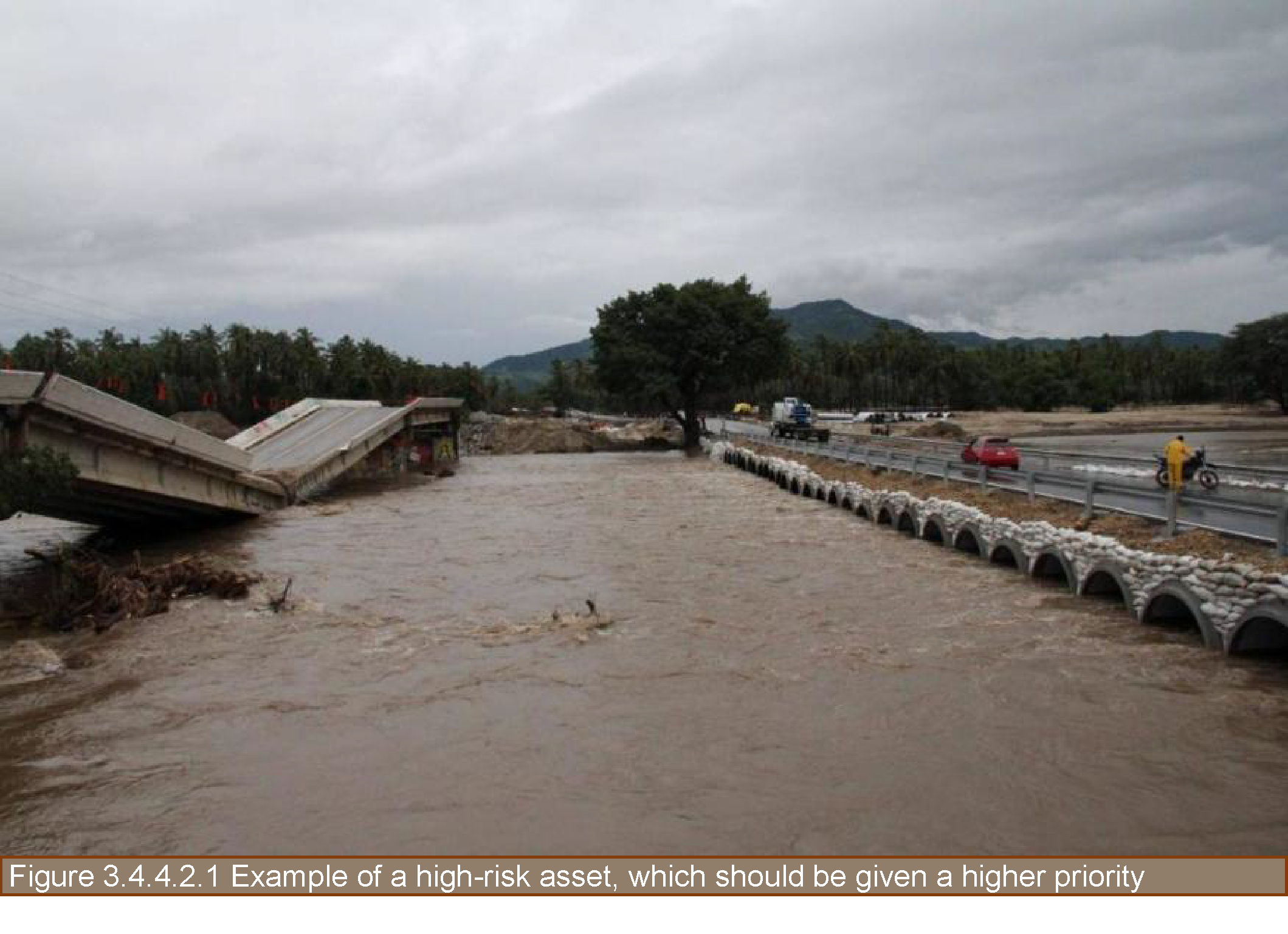
Candidate projects should also be prioritized depending on their lifecycle return on investment to ensure that value for money is achieved, particularly in the case of assets such as pavements, structures, or lighting (UKRLG and HMEP 2013). Again, road management systems usually help performing this task.
Modern prioritization procedures call for applying a multi-criteria approach in which factors such as sustainability, stakeholder requirements, and social benefits are combined with serviceability, safety, and value for money. This approach requires assigning appropriate weights to each factor depending on the institutional vision.
It should be noted that agencies at the proficient maturity level might not be in a position to apply the multi-criteria approach described above, while agencies at the basic level usually only use serviceability and economic return as criteria for prioritizing.
Inputs and outputs of the prioritization stage are illustrated in Figure 3.4.4.2.2.
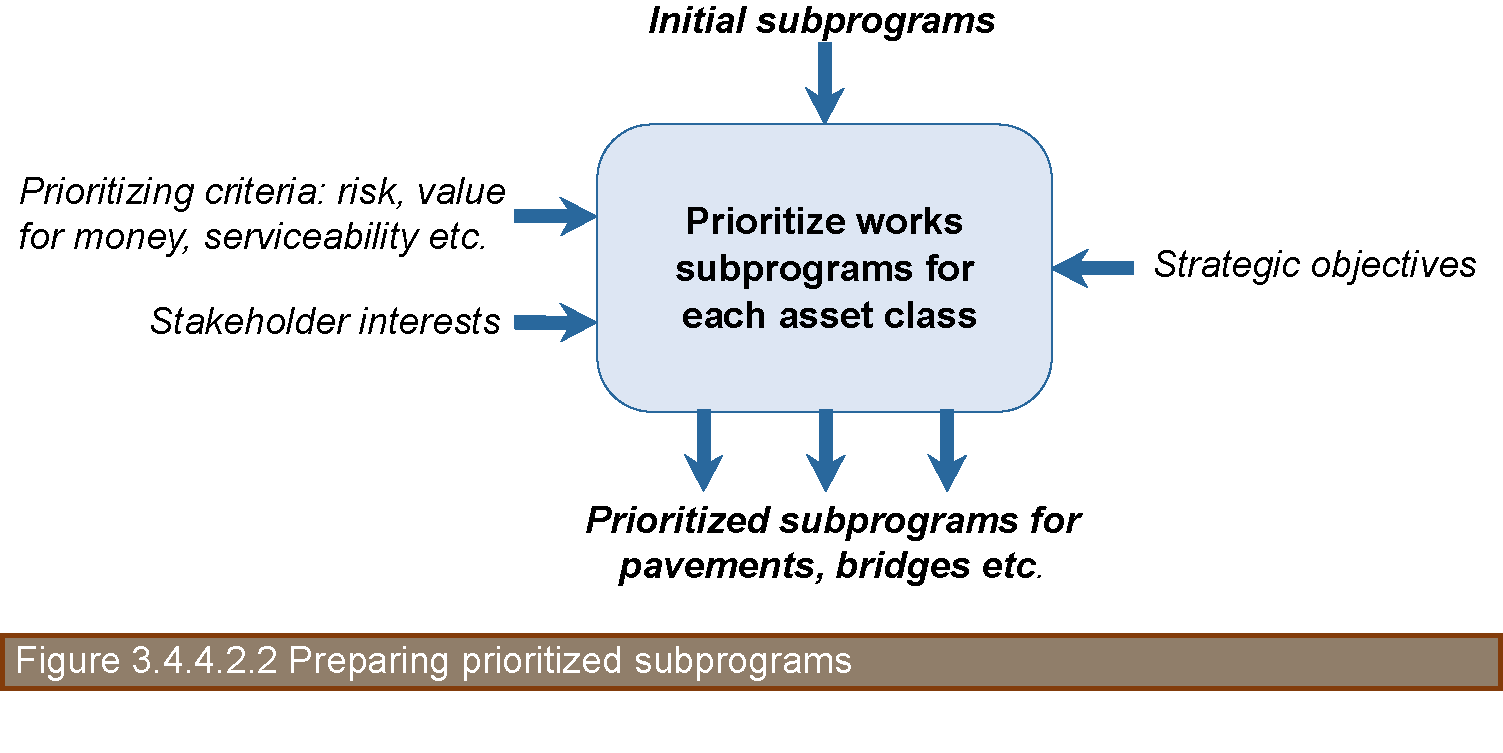
Multi-year programs comprise projects for the various asset classes to be executed within periods from three to five years (UKRLG and HMEP 2013). When information is available, programs can be developed for longer periods, e.g., 10 or more years. The preparation of multi-year programs is an essential phase of the programming process where project-level needs are reconciled with network-level resource constraints and performance goals.
The multi-year program supports financial planning by demonstrating what projects needs to be done and where and when they are to be undertaken. This planning must be reviewed annually and updated using the latest information available.
A multi-year program should indicate the amounts of funding corresponding to routine, preventive, and periodic maintenance, as well as resources intended for rehabilitation and construction (Austroads 2009). It should also contain details of the specific works considered for budget allocation. These features may be challenged by senior decision makers, so multi-year programs need to be robust and based on reliable information.
The list of projects to be included in the multi-year program is compiled by selecting projects from the prioritized program and adding up the costs estimated for each project until the forecasted budget is exhausted. At the advanced maturity level, the asset management plan and the investment strategy serve as a basis for determining which projects should be selected.
For projects around the budget ceiling or those requiring significant investment, additional data may be required to verify any assumptions made. The actual benefits from obtaining these data should be carefully assessed when the costs and risks involved are significant (UKRLG and HMEP 2013).
Project selection from prioritized programs often involves an optimization process. In this context, optimization refers to selecting investment options from various alternatives with the aim of achieving the highest benefits from constrained resource levels (Austroads 2009). One of the ranking criteria used for optimizing the available budget is the incremental benefit-cost ratio, which seeks to maximize the economic benefits for each additional unit of expenditure (Morosiuk et al. 2006).
Various management systems provide optimization modules for conducting impact analyses of different funding scenarios (Austroads 2009). Scenarios that might be considered include current constrained funds, incremented funds, reduced funds, and changes in the level of service offered. Results can then be presented to senior management to either support a particular funding scenario or examine various scenario options.
In performing program optimization, considerations such as the following may also be addressed (UKRLG and HMEP 2013):
Optimization of works programs has been traditionally carried out separately for the various asset classes, with a different budget ceiling established for each class. Using this approach, the resulting multi-annual program is actually made up of as many subprograms as the number of asset classes included in the programming process. Organizations at the advanced maturity level of asset management consider the implementation of methods for optimizing resource allocation across asset classes, using optimization processes based on a multi-criteria approach similar to that described for the prioritization stage.
Figure 3.4.4.3 shows the main information flows occurring at this stage of the programming process.
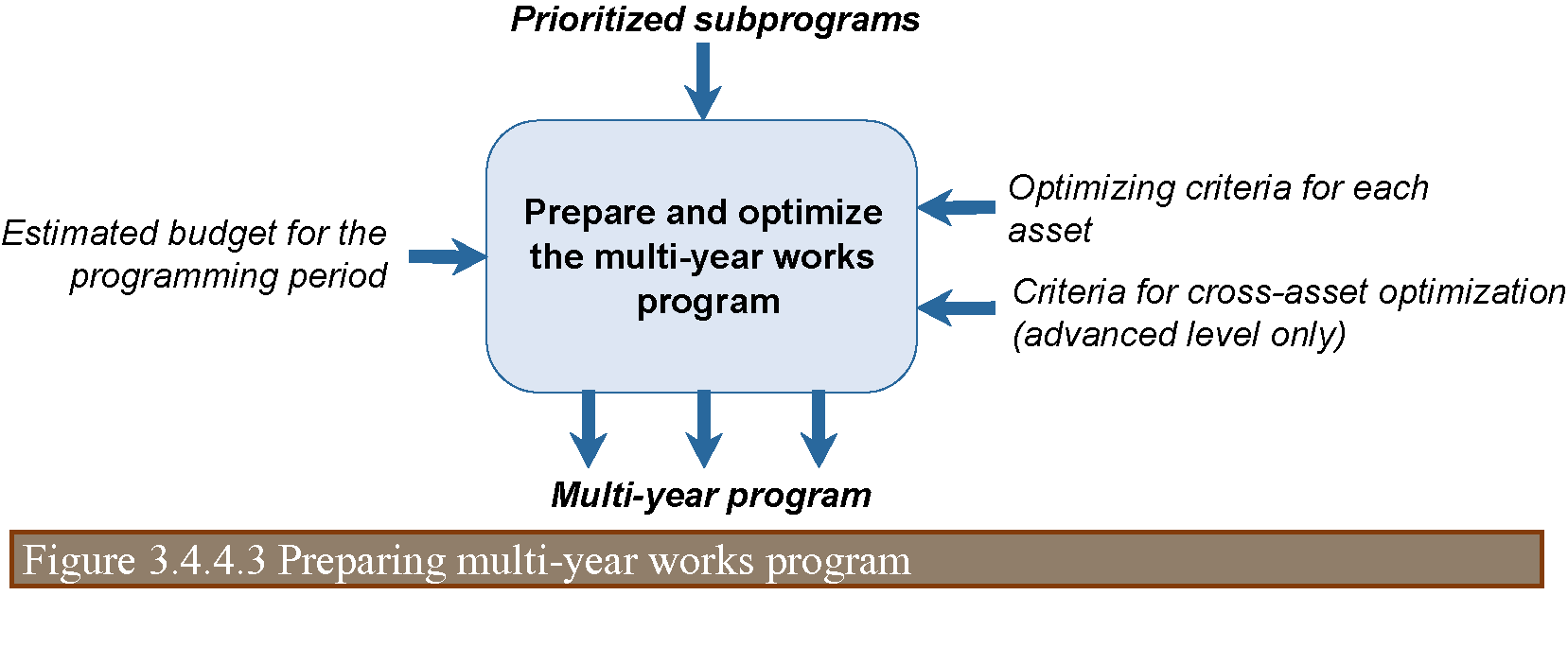
As mentioned above, organizations at the basic level only support development of annual works programs. In this case, the preparation and optimization of the multi-annual program is omitted or, more precisely, the tasks described above are performed using an analysis period of one year, and cross-asset optimization is not addressed.
The multi-annual program should be reviewed annually to update the list of projects with the highest priority that can be delivered from the available budget and produce an annual works program or annual plan (UKRLG and HMEP 2013).
In generating the annual program, consideration must be given to projects deferred in the last year, the backlog of needs, and the updated availability of resources (Austroads 2009). Projects in the annual works program should already have undergone a detailed design process and be ready for delivery. This enables contractors to plan the works properly and minimize any potential risks. In project design, the collection of additional detailed data on the involved assets should be considered to ensure that the proposed intervention produces the expected outcomes. Also, a more detailed cost estimate for each project should be made allowing a suitable contingency for risk (UKRLG and HMEP 2013).
Paragraph 3.4.4.3 introduces cross-asset allocation as a means of distributing resources among asset classes during the optimization of multi-year works programs. Actually, from a conceptual point of view, cross-asset allocation constitutes a complete programming approach on its own that makes use of advanced asset management components such as strategy, performance and risk. The following paragraphs discuss the concept of cross-asset allocation, and its potential as an effective tool for achieving the strategic goals of road organizations. Also, a procedure based on the international experience in applying this approach is outlined.
Cross-asset allocation involves the distribution of resources among road investment programs in order to realize the strategic objectives of the organization responsible (see paragraph 1.4.4.1). An investment program may refer to any works program intended to maintain or improve asset condition, but also to impact other performance areas such as safety, mobility or sustainability. In general, road attributes modifiable through investment programs may be designated as “drivers for renewal / maintenance” (AM4INFRA 2019).
The allocation of resource among investment programs is a complex task that starts with determining optimal solutions for single assets / operational issues. Many organizations have implemented advanced management systems for pavements, bridges and road safety, but only a few of them have appropriate tools for other areas. Since asset management implies assessing the level of service of a road network as a whole, the next step should be allocating constrained resources across the various investment programs. A question immediately arises: what (consistent) measures should be used to compare the benefits of the different programs among them?
During the 2009-2012 cycle, the PIARC technical committee on asset management carried out a study to identify the main approaches used by member countries to allocate resources among different assets (PIARC 2012-b). The study showed that the most common distribution method remained a percentage split of budget based on historical allocation. Nevertheless, road organizations already had envisaged the future use of more formal methods such as risk ranking, comparison of economic indicators (NPV, BCR and IRR), and multicriteria analysis.
Later on, the implementation of holistic asset management in a number of countries worldwide, led to the application of increasingly sophisticated procedures for coordinating, prioritizing and optimizing all maintenance activities on the different asset classes, as found by PIARC technical committee on asset management that worked through the 2013-2015 cycle (PIARC 2016). The study carried out by this committee quotes a Trans-European ENR research project known as PROCROSS, which identified three basic approaches to cross-asset allocation used in European countries (ENR 2012): bottom-up, top-down, and a combination of these. According to the project, all three approaches are valid and consistent in finding an optimum solution based on existing preconditions
A general description of the approaches identified by PROCROSS is presented in paragraph 3.4.5.3.
As pointed out in section 1.2, many road organizations around the world still operate under a silo-like structure, in which the various physical and operational issues like pavement condition or mobility are managed separately with a limited consideration of the organization strategic objectives.
Adverse effects of the traditional practice include (Deix, Alten, & Weninger-Vycudil, 2012):
Cross-asset allocation has been conceived to overcome disadvantages such as the above. In contrast with traditional methods, a cross-asset approach provides means for analyzing concurrently the benefits from different investment alternatives for each asset / operational issue so that the strategic objectives are attained more effectively and efficiently.
As mentioned previously, the ENR PROCROSS project identified the following approaches to cross-asset allocation as part as the asset management practice in Europe:
Bottom-up approach. This first method, portrayed in figure 3.4.5.3.1, is strongly influenced by the technical assessment of individual groups of assets / projects. Usually, each single group is analyzed separately by specific management systems that facilitate selection of appropriate alternatives under a certain number of given monetary or non-monetary preconditions.
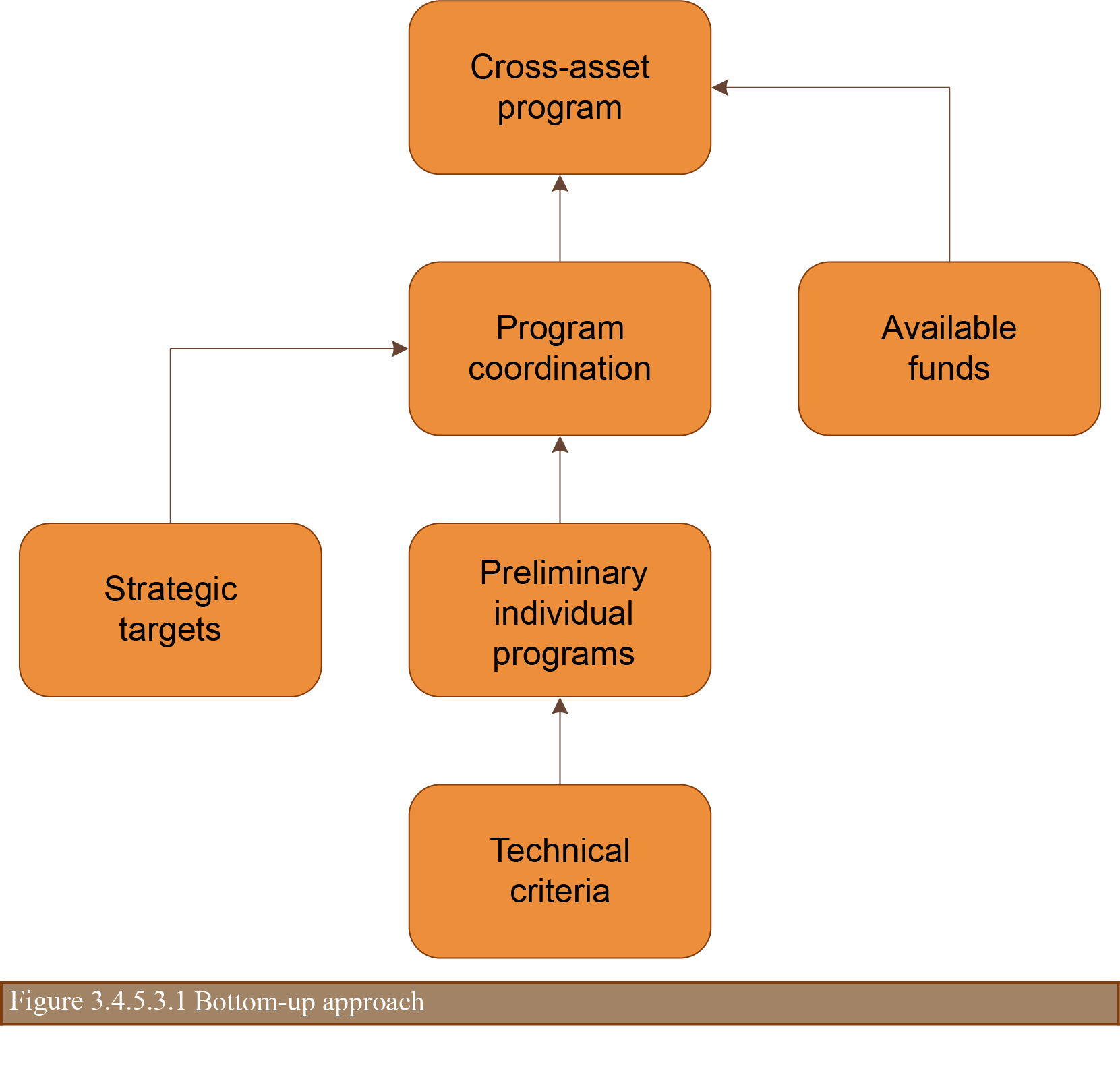
The cross-asset process is usually not carried out at this application level, but the results can be used in a subsequent process of “coordination” across the individual groups. This process recalls the strategic objectives and targets, and may alter significantly the technically optimal solutions originally found.
The comprehensive appraisal of asset technical need constitutes the main advantage of the bottom-up approach. However, this feature represents also its main weakness since the focus on technical aspects leave the strategic objectives only rudimentarily considered.
Top-down approach. According to PROCROSS definitions, a top-down approach (Figure 3.4.5.3.2) is based on high-level, central decisions that consider the road network as a whole. It assumes that the overall performance of the network can be improved if its various assets / attributes are addressed concurrently rather than on a single basis.
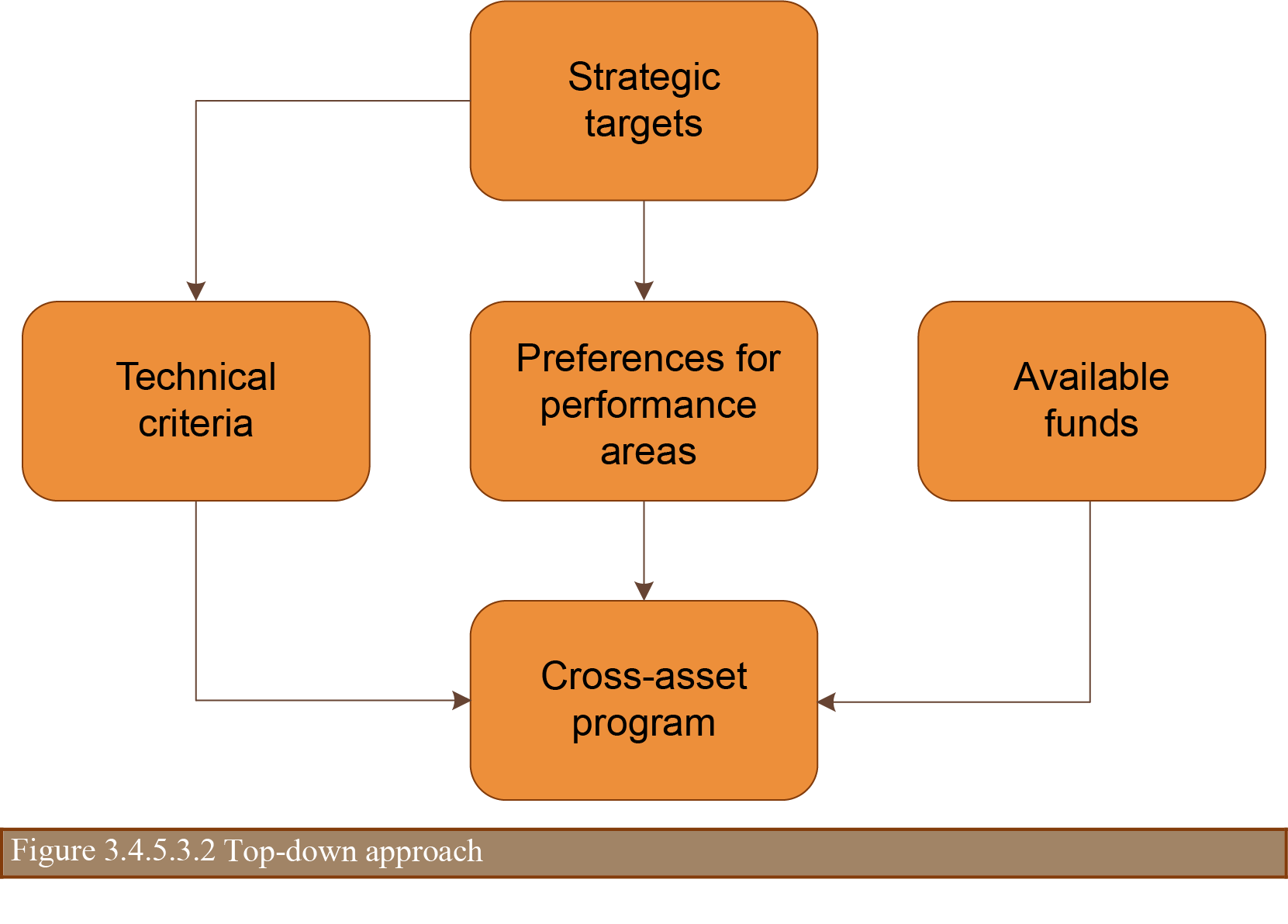
The application of a top-down approach requires a deep understanding of the performance of the network, in order to give preference to those programs that better contribute to achieve the desired or feasible strategic targets.
A top-down approach provides clear and comprehensive criteria for analyzing assets at the technical level. However, this does not imply that engineering considerations are applied to the necessary extent, which increment risks related to achieving the levels of service pursued.
Combined approach. A combined bottom-up top-down approach, as represented in figure 3.4.5.3.3, entails the evaluation of the technical results of single assets in terms of the organization’s strategic targets. A critical issue for this approach is conciliating the strategic and the engineering requirements.
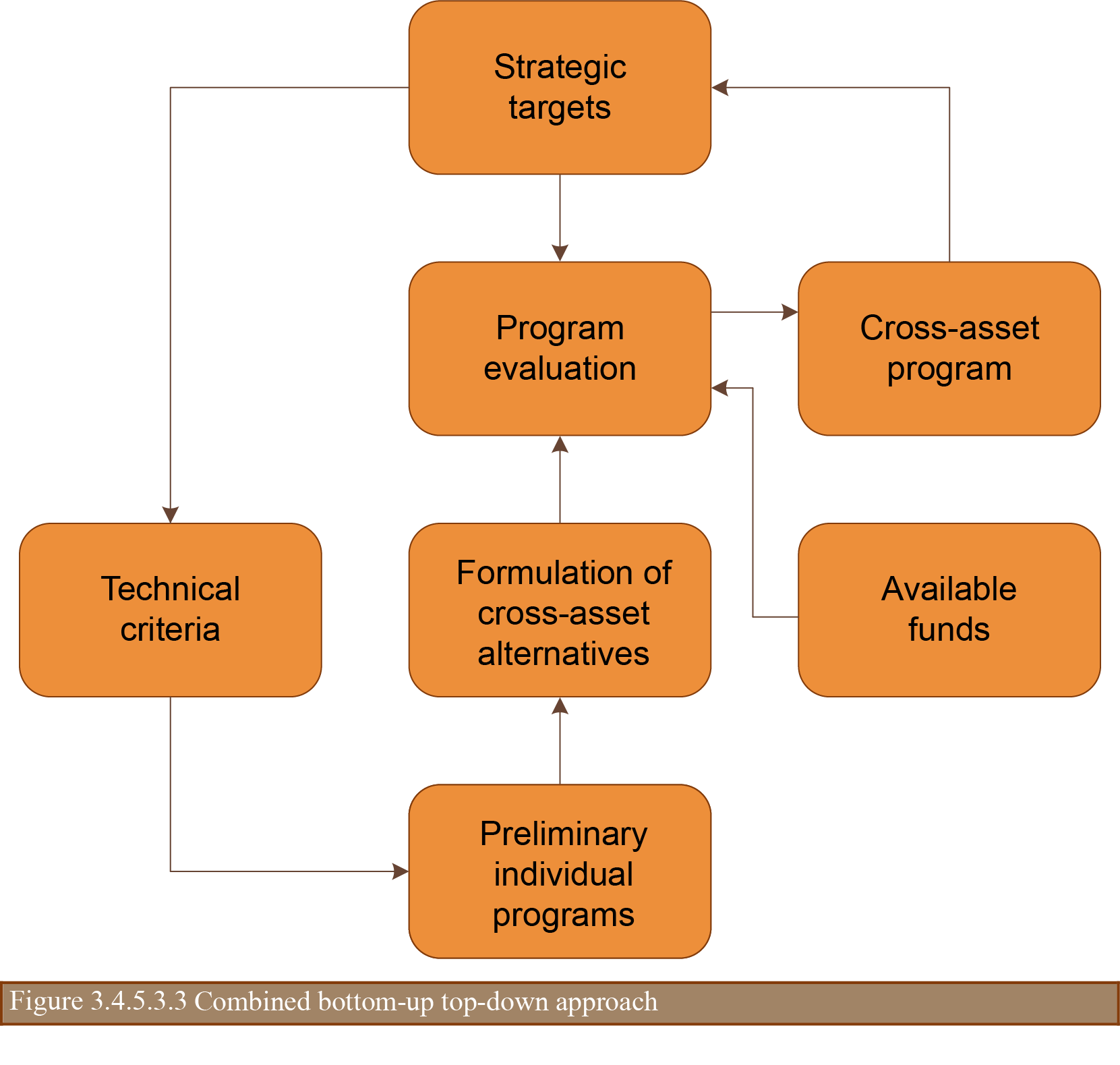
In the combined approach, the cross-asset allocation process usually occurs at an intermediate level between the strategic and the project levels. Under this approach, one the main objectives of works programming consists in harmonizing the strategic targets and the technical specifications by finding an optimal point that maximizes the fulfillment of the strategic objectives while reducing as much as possible the risk associated with the actual level of service provided. This is not an easy task as projects often do not comply with strategic criteria because they come as a result of a prioritization / optimization process that relies mainly on simple ranking and not from a network-wide performance analysis.
The final report of the PROCROSS project (ENR 2012) includes a specific cross-asset allocation procedure, which is based in the combined approach described above and comprises the following activities:
A procedure for cross-asset allocation is also provided in the Report 806 of the US National Cooperative Highway Research Program (Maggiore, Ford, CH 2M Hill, High Street Consulting Group & Burns & McDonell, 2015). In this case, the procedure is made up of the tasks below:
Form the above listings, it can be concluded that both procedures are quite similar, even though the PROCROSS method do not include a step for comparing the effects of funding levels.
A further procedure for cross-asset allocation is presented next. Although, on the one hand, this procedure is based on the two methods outlined previously, on the other hand it assumes that the organization has developed a performance framework (see section 1.4) so the following items are already available:
Given the above, a cyclical procedure for cross-asset allocation can be depicted as shown in Figure 3.4.5.4.
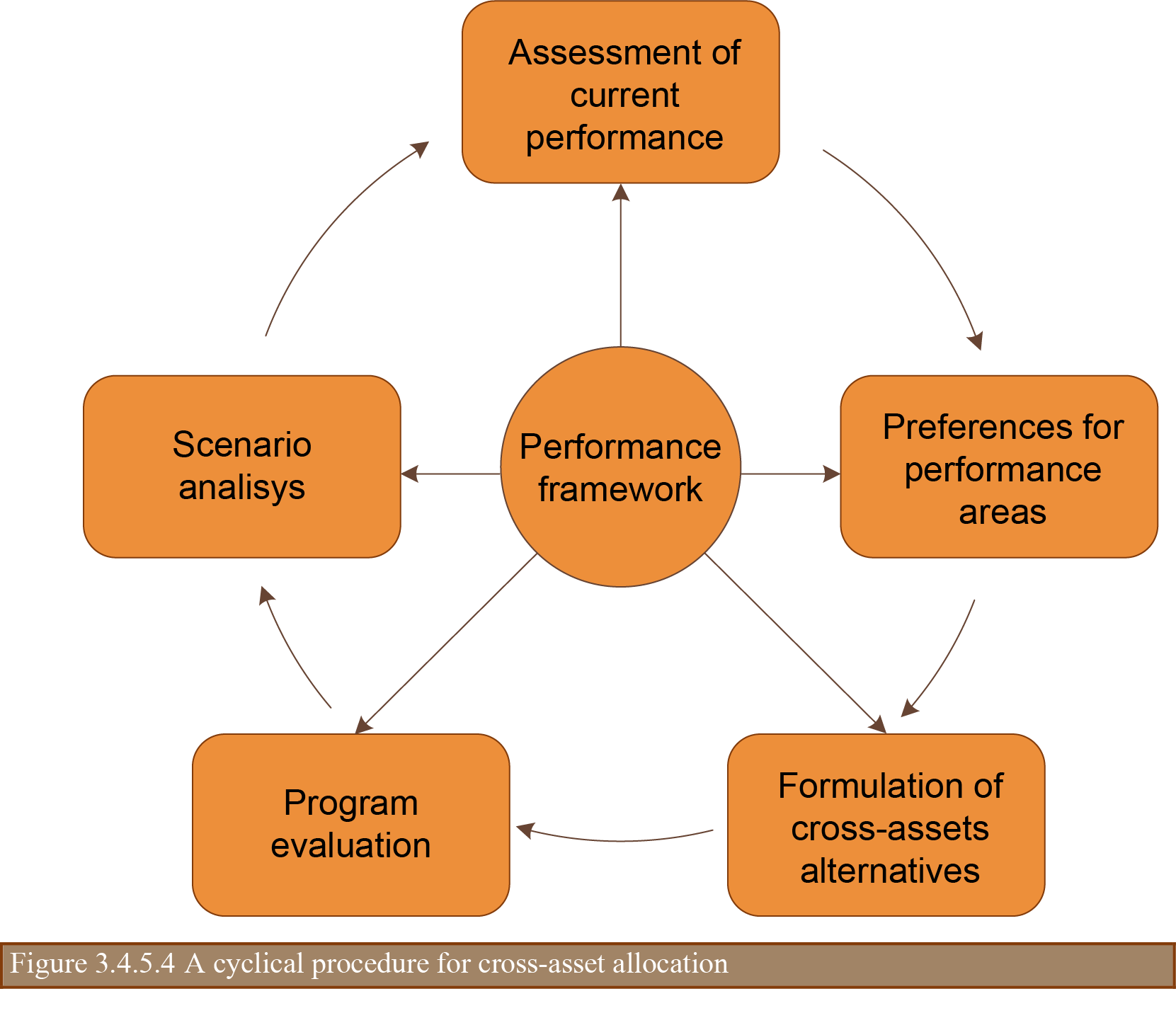
The steps illustrated in this figure can be described as follows:
Assessment of current performance. It implies determining the organization progress in reaching the strategic targets defined within the performance framework. Any difference will represent a performance gap that has to be addressed through the proposed investment programs.
Development of individual programs. Works dealing with improving the condition of individual assets or any other attribute of the road network are identified in this step using specialized management systems for each asset / operational issue (pavements, bridges, safety, etc.) The resulting programs are intended to minimize the risk of not achieving the targets proposed for each performance area.
Formulation of cross-asset alternatives. Combines the projects selected for the individual programs in order to cover all performance areas with a single works program. Also, define alternative programs containing project options different from those selected in the previous step so that the preferences stated in the performance framework can be considered while carrying out cross-asset allocation under budget constraints.
Program evaluation. Refers to a decision-making process that should be applied to identify, using diverse criteria, the alternative of a cross-asset program that best contributes to attaining the targets specified in the performance framework. This involves comparing projects in terms of their benefits, which are normally expressed in different units depending on the performance area addressed by each project. Thus, all benefits should be normalized (i.e. converted to a common metric) to allow for comparison.
The international experience on cross-asset works programming comprise the application of decision-making techniques such as the following (Proctor & Zimmerman, 2016; Porras-Alvarado, Han, & Zhang, 2014):
The multi-criteria analysis may provide various advantages. First, the analyst priorities are specifically declared through the assignment of weights to the different performance areas. At the same time, the decision maker objectives are clarified while translating them into criteria for evaluating intervention alternatives. Furthermore, the system for evaluating alternatives is transparent since it leaves a clear record of the weights and criteria applied. Finally, the multi-criteria analysis is flexible as it permits criteria to be added as well as disparate criteria to be used.
However, it also has disadvantages: i) Costs and risks are not explicitly involved in the analysis; ii) Results are very sensitive to the values attributed to weights, so these can be determinant of the alternatives selected.
Cross-asset optimization involves the use of recursive mathematical procedures to find the maximum level of benefits that can be produced by a given set of investments subject to technical performance requirements and budget constraints. Its application implies the use of a software capable of evaluating a considerable number of options (hundreds or even thousands) to find the one yielding the greatest benefits. It this way, cross-asset optimization generates more sophisticated and quantified results, yet it requires extensive data about all candidate projects evaluated.
Scenario analysis. This last step is equivalent to the last step of the cross-asset allocation procedure proposed in the US NHCRP Report 806 (Maggiore, Ford, CH 2M Hill, High Street Consulting Group, & Burns & McDonell, 2015). As the latter, it consists of determining the effects of various investment scenarios and funding levels in the performance of the road network both as a whole and considering each individual asset / operational feature individually. The results of such an analysis can be used to identify the needs of stakeholders concerning the different performance areas and the budgeting required to meet those requirements, and eventually to modify appropriately the performance targets in use.
Finally, it should be noted that the procedure described above is based on the combined approach for cross-asset allocation portrayed in figure 3.4.5.3.3, as it starts with the individual analysis of each of the different performance areas, and then it combines candidate projects from the different programs to obtain a solution oriented towards achieving the performance goals of the road organization.
AM4INFRA 2019. Asset Management Approach for Transport Infrastructure Network (http://www.am4infra.eu/downloads/).
Austroads. 2009. Guide to Asset Management Part 4: Program Development and Implementation. Austroads Inc. Sydney, Australia.
—. 2002. "Integrated Asset Management Guidelines for Road Networks." Austroads Publications Online. Accessed April 9, 2015 (https://www.onlinepublications.austroads.com.au/items/AP-R202-02).
Cambridge Systematics, Inc., Parsons Brinckerhoff Quade & Douglas, Inc., Ray Jorgenson Associates, Inc., and Paul D. Thompson. 2002-1. Transportation Asset Management Guide. American Association of State Highway and Transportation Officials. Washingtom, D.C.
Cambridge Systematics, Inc., Parsons Brinckerhoff Quade and Douglas, Inc., Roy Jorgensen Associates, Inc., and Paul D. Thompson. 2002-2. Phase I Report Task 2 of 3: Asset Management Framework. NCHRP Web Document 41. National Cooperative Highway Research Program, Washington, DC. Last accessed July 30, 2015 (http://onlinepubs.trb.org/onlinepubs/nchrp/nchrp_w41_task2.pdf).
Cambridge Systematics, Inc. 2004. FHWA Asset Management Position Paper. Federal Highway Administration. Last accessed February 27, 2017 (https://www.fhwa.dot.gov/infrastructure/asstmgmt/ampp.pdf).
Deix, S., Alten, K., & Weninger-Vycudil A. 2012. “Procedures for Cross Asset Management Optimisation”. Procedia: Social and Behavioral Sciences - Transportation Research Arena 2012. Elsevier Ltd (https://core.ac.uk/download/pdf/82017388.pdf).
ENR 2012. PROCROSS: Development of Procedures for Cross Asset Optimisation - Final Report. ERA-NET Road (http://www.cedr.eu/download/other_public_files/research_programme/eranet_road/call_2010_asset_management/procross/PROCROSS-D4.-Final-report-%25E2%2580%259CThe-Procedures-for-Cross-Asset-Management-Optimisation.pdf).
Federal Highway Administration (FHWA) Transportation Asset Management Expert Task Group. 2013-1. AASHTO Asset Management Guide—A Focus on Implementation. Executive Summary. American Association of State Highway and Transportation Officials. Washington, DC. Last accessed July 29, 2015 (http://www.fhwa.dot.gov/asset/pubs/hif13047.pdf).
Federal Highway Administration (FHWA). 2013. Generic Work Plan for Developing a TAMP. Federal Highway Administration Office of Asset Management. Last accessed July 30, 2015 (http://www.fhwa.dot.gov/asset/tamp/workplan.pdf).
Maggiore, M., Ford K. M., CH 2M Hill, High Street Consulting Group & Burns & McDonell. 2015. NCHRP Report 806: Guide to Cross-Asset Resource Allocation and the Impact on Transportation Systems Performance. Washington, D.C., United States of America. Transportation Research Board (http://www.trb.org/Publications/Blurbs/172356.aspx).
Morosiuk, Greg, Mike Riley, and Tyrone Tool. 2006. HDM-4: Highway Development and Management. Volume Two: Applications Guide. World Road Association (PIARC). Paris, France.
Robinson, Richard, Uno Danielson, and Martin Snaith. 1998. Road Maintenance Management: Concepts and Systems. Macmillan. Basingstoke, Hampshire, UK.
PIARC 2000. Planning & Budgeting on Road Network Level - Presentation of Budgets for Decision-Makers, Committee on Road Management (6), ISBN 2-84060-113-3 (https://www.piarc.org/en/order-library/3770-en-Planning%20-%20Budgeting%20on%20Road%20Network%20Level%20-%20Presentation%20of%20Budgets%20for%20Decision-Makers.htm).
PIARC 2012-a. Allocation of Resources Across Asset Classes. Technical Committee D.1 – Management of Road infrastructure Assets. ISBN: 978-2-84060-286-5 (https://www.piarc.org/ressources/publications/1/17110,2012R21-EN.pdf).
PIARC 2012-b. High Level Management Indicators. Technical Committee D.1 – Management of Road Infrastructure Assets. ISBN: 978-2-84060-288-1 (https://www.piarc.org/ressources/publications/8/18287,2012R22-EN.pdf).
PIARC 2016. Assessment of Budgetary Needs and Optimisation of Maintenance Strategies for Multiple Assets of Road Network (https://www.piarc.org/ressources/publications/8/24533,2016R04EN.pdf).
Porras-Alvarado, D., Han, Z., & Zhang, Z. 2014. “A Fair Division Approach to Performance-based Cross-Asset Resource Allocation”. Proceedings of the 9th International Conference on Managing Pavement Assets. Alexandria, Virginia, United States of America (https://vtechworks.lib.vt.edu/handle/10919/56420).
Proctor, G., & Zimmerman K. 2016. Defining Cross-Asset Decision Making: A Discussion Paper. AASHTO (https://www.tam-portal.com/wp-content/uploads/2016/01/Cross-Asset-Allocation.pdf).
United Kingdom Roads Liaison Group (UKRLG) and Highways Maintenance Efficiency Programme (HMEP). 2013. Highway Infrastructure Asset Management Guidance Document. Department for Transport, London. Last accessed July 24, 2015 (http://www.ukroadsliaisongroup.org/en/utilities/document-summary.cfm?docid=5C49F48E-1CE0-477F-933ACBFA169AF8CB).
These practices have been tested in several instances and case studies are being prepared. They will be presented here when available. If you want to share a case study, please contact assetmanagementmanual@piarc.org.
One of the major components of Mexican roads is the federal toll-free network, which comprises 40,752 km of paved roads (Figure 3.4.6.1) and 7,483 bridges.
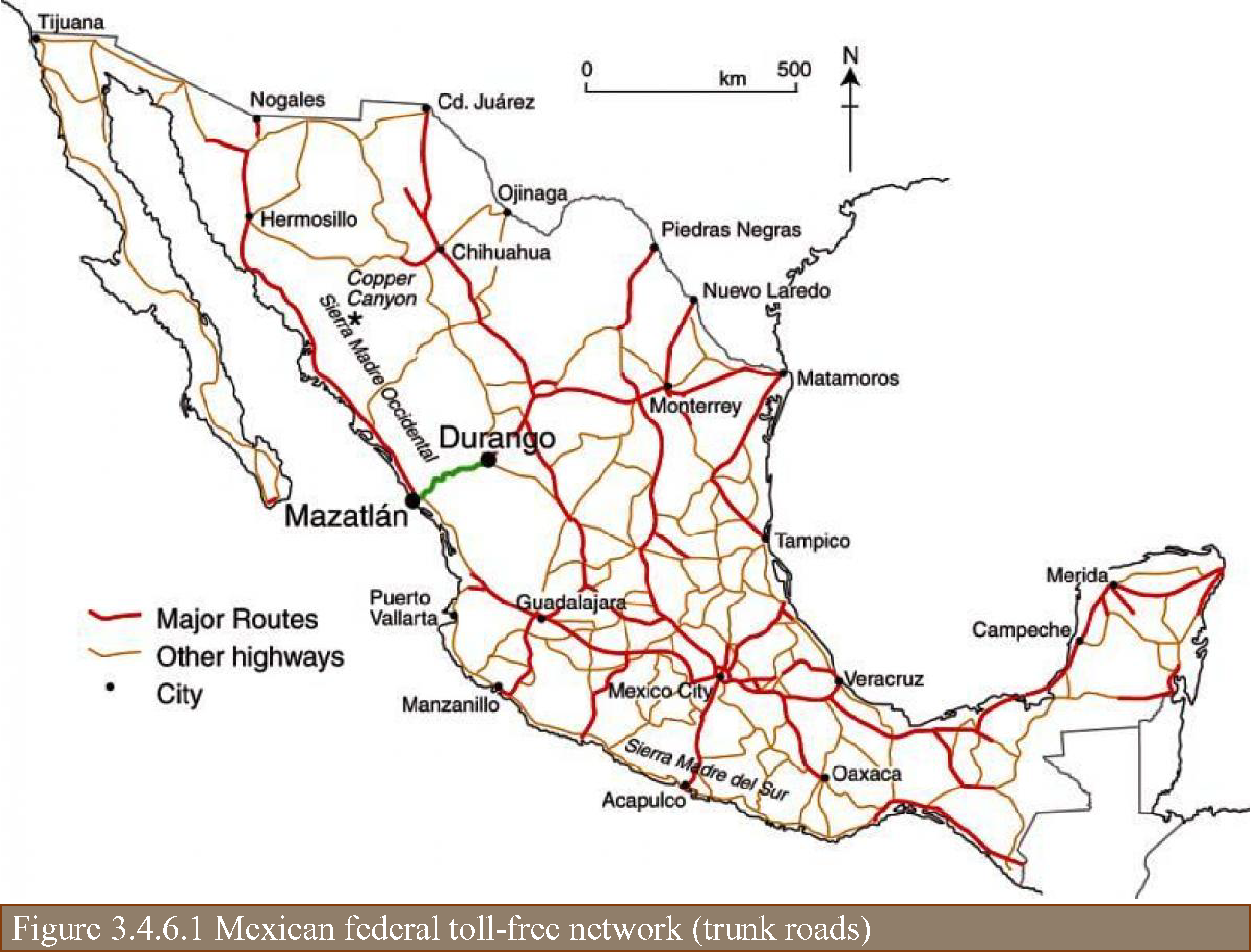
This part of the network is managed by the General Directorate of Road Maintenance (DGCC) of the Mexican Secretariat of Communications and Transport (SCT).
As part of the planning process implemented by the federal government for developing and preserving the federal roads, the DGCC prepares, on the one hand, a six-year plan for each period of the federal administration and, on the other hand, an annual road maintenance program. Both the six-year plan and the annual program are composed of a series of asset-specific subprograms, including pavement maintenance, bridge reconstruction, and black spot treatment.
The programming process for pavement maintenance is supported by a pavement management system, which makes use of HDM 4 for analyzing investment options. Based on information about pavement condition, traffic forecasts, and other data items, this process determines the set of pavement works yielding the greatest return on investment for the available resources. Other funding scenarios simulating budget cuts or the allocation of additional resources are also analyzed.
With regard to bridges, inspection data are used as input to the DGCC bridge management system in order to identify bridges requiring treatment, define the necessary bridge works, and prioritize the resulting works list using criteria such as current bridge condition, traffic volume, and the impact of failure on network connectivity. Resources are allocated to projects based on the priorities defined.
Finally, concerning black spots, a priority list is also prepared based on accident information provided by other areas of the SCT.
The DGCC has not yet implemented procedures for allocating resources among asset classes. However, in the final stage of the annual program preparation, a thorough review is performed to identify bridges and other structures involving high levels of risk and, eventually, redistribute parts of the available budget.